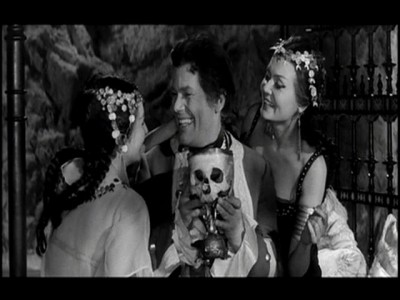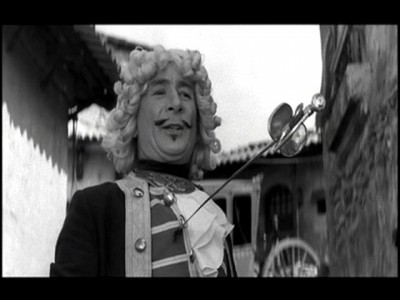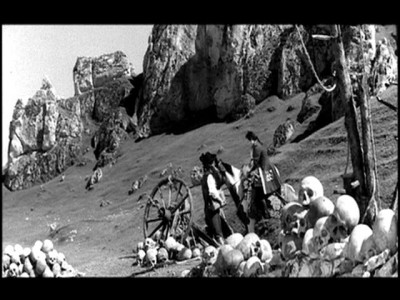| Reviews & Columns |
|
Reviews DVD TV on DVD Blu-ray 4K UHD International DVDs In Theaters Reviews by Studio Video Games Features Collector Series DVDs Easter Egg Database Interviews DVD Talk Radio Feature Articles Columns Anime Talk DVD Savant Horror DVDs The M.O.D. Squad Art House HD Talk Silent DVD
|
DVD Talk Forum |
|
|
| Resources |
|
DVD Price Search Customer Service #'s RCE Info Links |
|
Columns
|
|
|
Saragossa Manuscript, The
Other // Unrated // July 28, 2009
List Price: $29.95 [Buy now and save at Amazon]
The Series:
Originally released by Image years ago, Mr Bongo Films has reissued the surrealist masterpiece TheSaragossa

While fighting inSaragossa
Years earlier, Captain Alfons van Worden (Zbigniew Cybulski) was charged with finding the most direct path toMadrid

Dismissing their concerns the Captain moves out, but soon get separated from his men. He stumbles upon a strange cave, where a beautiful woman, one breast bared, says that the princesses she works for have invited him to dinner. Surprised to find anyone in the cave, much less princesses, he agrees and is led to another dingy chamber filled with a magnificent spread and gorgeous furniture. Two exquisite women present themselves and soon offer themselves up to be his brides, but only if he converts to Islam. Just as they are about to seduce him, Alfons wakes up, lying beneath the corpses of two hanged men in a makeshift gallows.
From here Alfons journey meanders like a mountain stream. He meets an old hermit priest, to whom he tells his story too, recounting the adventures of his father and how the elder Worden was famous for his sword duels. Flashing forward and back, with the same characters popping up in other people's stories the narrative soon gets muddled and twisted.

Based on an early 19th century book, this twisting film reminded me of the Arabian Nights, with its story-within-a-story-within-a-story narrative device and the colorful characters that populate the fiction. The movie is quite amusing at times, very erotic, exciting, but most of all mysterious. A surrealist film in a lot of ways, events are often just slightly skewed from reality. It starts at the very beginning when a (small scale) battle is raging in a small town. A French soldier runs to a demolished wall and falls. Minutes later an officer walks to the man, seemingly oblivious that bullets are flying, helps him up, and the presumed dead soldier runs away, good as new.
That scene, like many in the film, bring the viewers to as themselves what is real and what is just fiction. Is the book the two soldiers reading really true, or is it entirely made up? That question is at the heart of this film and one of the things that makes it such a masterpiece. All through the movie seemingly incompatible opposites are presented as being the same. The man is dead, but he's also alive. The princesses live in a dingy cave that is magnificently furnished. The Christian hermit is a Muslim Sultan. And so on. Once you see that, it's hard not to notice that pairs of things are also emphasized in the movie: two officers are reading the book, there are two princesses, two hanged men, and on and on.

This is one of those films whose ultimate meaning always seems to be just a hair's width away from your grasp. It makes so much sense at times, but then the next scene throws things askew once again. It's magnificent the way Has keeps the viewers guessing and questioning through the whole running time but never makes things so surreal or disjointed that interest is lost.
In addition to a perplexing story, this film contains some lovely cinematography. The DP frames the images like still photos, and the shots are often held long enough for people to appreciate them as art. Even if the non-linear story doesn't hold your interest, the beautiful scenes will.
Audio:
The haunting score by Krzysztof Penderecki is magnificent and adds a lot to the feel and atmosphere of the film. From the opening where Beethoven's "Ode to Joy" is playing while a battle is being fought in a war viewers know that they are in for a special aural experience. The music continues the themes of the film in a way few other soundtracks are able to. The two channel audio is generally clear and while it is hampered by recording technology of the time, it still does a good job.
Video:
This movie is presented with the odd aspect ratio of approximately 2:1. Not only that, but it seems to be flagged oddly on the disc. I ended up putting the disc is several players (which were properly set up and matched to their displays) and the resulting image was not consistent. Some times the framing looked wrong and in other players it looked fine. In any case though the disc is labeled as anamorphic there were always black bars at the top and bottom of the screen.
The image quality itself was pretty good. The black and white images were clear and had an adequate level of detail. The contrast was good and I didn't see any evidence of cross colorization and only the slightest aliasing.
Extras:
While the case says that there is an isolated music score, I couldn't find it anywhere on the disc. The only extra was an image gallery. The Image release reportedly included a insert essay on the film, which is not present in this release.
Final Thoughts:
This is an all around wonderful film, especially if you like challenging narratives and non-linear stories. The cinematography, music, and tale all come together to create a nearly lost masterpiece. Highly recommended.
Originally released by Image years ago, Mr Bongo Films has reissued the surrealist masterpiece The

While fighting in
Years earlier, Captain Alfons van Worden (Zbigniew Cybulski) was charged with finding the most direct path to

Dismissing their concerns the Captain moves out, but soon get separated from his men. He stumbles upon a strange cave, where a beautiful woman, one breast bared, says that the princesses she works for have invited him to dinner. Surprised to find anyone in the cave, much less princesses, he agrees and is led to another dingy chamber filled with a magnificent spread and gorgeous furniture. Two exquisite women present themselves and soon offer themselves up to be his brides, but only if he converts to Islam. Just as they are about to seduce him, Alfons wakes up, lying beneath the corpses of two hanged men in a makeshift gallows.
From here Alfons journey meanders like a mountain stream. He meets an old hermit priest, to whom he tells his story too, recounting the adventures of his father and how the elder Worden was famous for his sword duels. Flashing forward and back, with the same characters popping up in other people's stories the narrative soon gets muddled and twisted.

Based on an early 19th century book, this twisting film reminded me of the Arabian Nights, with its story-within-a-story-within-a-story narrative device and the colorful characters that populate the fiction. The movie is quite amusing at times, very erotic, exciting, but most of all mysterious. A surrealist film in a lot of ways, events are often just slightly skewed from reality. It starts at the very beginning when a (small scale) battle is raging in a small town. A French soldier runs to a demolished wall and falls. Minutes later an officer walks to the man, seemingly oblivious that bullets are flying, helps him up, and the presumed dead soldier runs away, good as new.
That scene, like many in the film, bring the viewers to as themselves what is real and what is just fiction. Is the book the two soldiers reading really true, or is it entirely made up? That question is at the heart of this film and one of the things that makes it such a masterpiece. All through the movie seemingly incompatible opposites are presented as being the same. The man is dead, but he's also alive. The princesses live in a dingy cave that is magnificently furnished. The Christian hermit is a Muslim Sultan. And so on. Once you see that, it's hard not to notice that pairs of things are also emphasized in the movie: two officers are reading the book, there are two princesses, two hanged men, and on and on.

This is one of those films whose ultimate meaning always seems to be just a hair's width away from your grasp. It makes so much sense at times, but then the next scene throws things askew once again. It's magnificent the way Has keeps the viewers guessing and questioning through the whole running time but never makes things so surreal or disjointed that interest is lost.
In addition to a perplexing story, this film contains some lovely cinematography. The DP frames the images like still photos, and the shots are often held long enough for people to appreciate them as art. Even if the non-linear story doesn't hold your interest, the beautiful scenes will.
The DVD:
Audio:
The haunting score by Krzysztof Penderecki is magnificent and adds a lot to the feel and atmosphere of the film. From the opening where Beethoven's "Ode to Joy" is playing while a battle is being fought in a war viewers know that they are in for a special aural experience. The music continues the themes of the film in a way few other soundtracks are able to. The two channel audio is generally clear and while it is hampered by recording technology of the time, it still does a good job.
Video:
This movie is presented with the odd aspect ratio of approximately 2:1. Not only that, but it seems to be flagged oddly on the disc. I ended up putting the disc is several players (which were properly set up and matched to their displays) and the resulting image was not consistent. Some times the framing looked wrong and in other players it looked fine. In any case though the disc is labeled as anamorphic there were always black bars at the top and bottom of the screen.
The image quality itself was pretty good. The black and white images were clear and had an adequate level of detail. The contrast was good and I didn't see any evidence of cross colorization and only the slightest aliasing.
Extras:
While the case says that there is an isolated music score, I couldn't find it anywhere on the disc. The only extra was an image gallery. The Image release reportedly included a insert essay on the film, which is not present in this release.
Final Thoughts:
This is an all around wonderful film, especially if you like challenging narratives and non-linear stories. The cinematography, music, and tale all come together to create a nearly lost masterpiece. Highly recommended.
|
| Popular Reviews |
| Sponsored Links |
|
|
| Sponsored Links |
|
|
| Release List | Reviews | Shop | Newsletter | Forum | DVD Giveaways | Blu-Ray | Advertise |
|
Copyright 2024 DVDTalk.com All Rights Reserved. Legal Info, Privacy Policy, Terms of Use,
Manage Preferences,
Your Privacy Choices | |||||||














